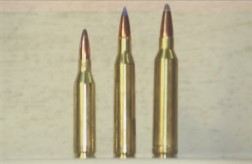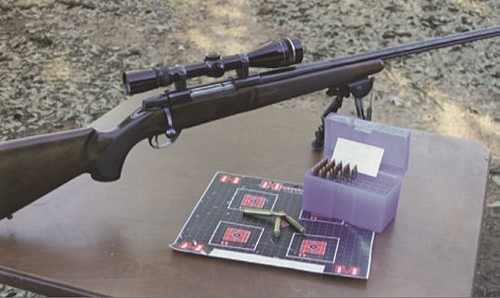Ken Delano & Doug Hill | Originally published in GameKeepers: Farming for Wildlife Magazine. To subscribe, click here.

The .25-06 is a marriage of the quarter-inch bore with the old standby .30-06 cartridge case. It was first introduced around 1920 by gunsmith A. O. Neidner and existed as a wildcat cartridge for many years. Remington standardized the cartridge and brought it out in commercial form in 1970.
As a dual-purpose cartridge (varmints to medium game), the .25-06 stretches the effectiveness of the .243/6mm on the larger-game end of the spectrum. Many will argue the .25-06 is not an elk rifle, but developments in projectile technology have really made bore size less of an issue and bullet construction and placement king. Premium construction .25 caliber bullets of 90- to 120-grains will certainly handle elk on the broadside, double-lung hits, though maybe not the best choice in heavy timber or for more challenging shot angles.

the .243 Winchester on the left and
7mm Remington Magnum on the
right.
For anything from coyotes to large deer, the .25-06 shines. Its flat-shooting capabilities are legendary and well-earned; and if it's effective at 350 yards, it's also effective at 50 yards, and therefore a fine, do-it-all rifle for coyotes across a row crop field to whitetails in the woods to pronghorns on the plains.
Factory ammo offerings range from 85-grain varminters to 100- and 120-grain premium construction bullets. For shooting deer-size game, I lean toward the heavier 115-120 grain bullets. Their superior ballistic coefficient compared to 100-grain bullets makes them better at long range, and their typically heavier construction holds up better and isn't as destructive to edible meat. This doesn't apply to monolithic construction bullets such as the Barnes, which may be lighter (like 90-95 grains) but shares ballistic properties with traditional cup-and-core style bullets in the 115- 120-grain range.
The .25-06 is a classic bolt-action rifle cartridge. It’s hard to picture it as appropriate in a lever gun, pump or autoloader, though a Ruger No. 1 makes an appropriate home for the cartridge. One of my all-time favorite bolt guns which, sadly, I no longer have, was a tang-safety Ruger 77 in .25-06. This was the model with the 24” medium sporter barrel, and was superbly accurate with the 100 grain Speer HP and 4064 powder.
Author Hill writes: I consider the .25-06 a near-perfect choice for deer and antelope size game with proper 100-115 grain bullets. This combination is light in recoil which always helps with good shot placement, and flat-shooting enough that we don't need to worry about hold-over in most hunting conditions. The Sierra reloading manual gives the .25-06 with their 100-grain boat tail spitzer at 3200 feet per second a maximum point-blank range (no hold-over) of 360 yards. What that means is with a 300 yard zero, the bullet will not be more than 5" above or below our aiming point out to that range. That's farther than I have any business shooting at game under most field conditions.

situations this rifle couldn't cover effectively.
The 25-06 is popular with handloaders due in part to the many .257" diameter bullets available. I shoot a heavy-barrel Sako in this caliber that is very fond of the Sierra 90 gr. boat tail hollow point bullet. When loaded over 57 grains of H 4831, this combination has proven to be one of the most accurate rifle/load combinations I have. I have used the 115-grain Nosler Partition as well as the 120-grain Speer hollow point on several whitetails and feral hogs with good success. Having loaded and hunted with Partition bullets for 40+ years. they are my go-to bullet for big game, so the 115 grain over 54 grains of H 4831 is my choice for whitetails. These loads are safe in this particular rifle, but be sure to consult a reloading manual for your load data and be sure to start lower and work up.
While the 25-06 does not have "Magnum" stamped on the case head, it is a very capable round and worthy of consideration for almost any application we have here in the US. All in all, a great GameKeeper cartridge choice.




























